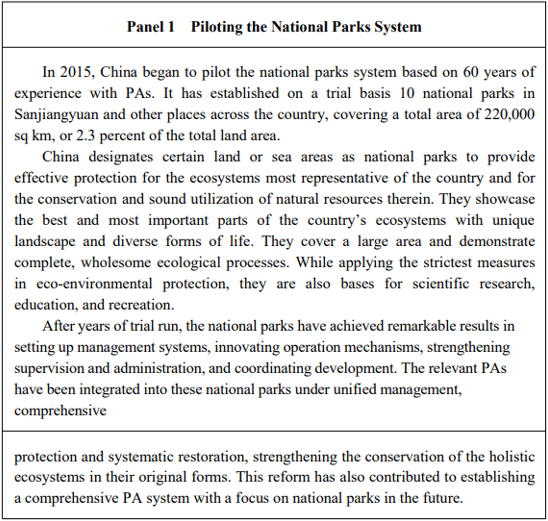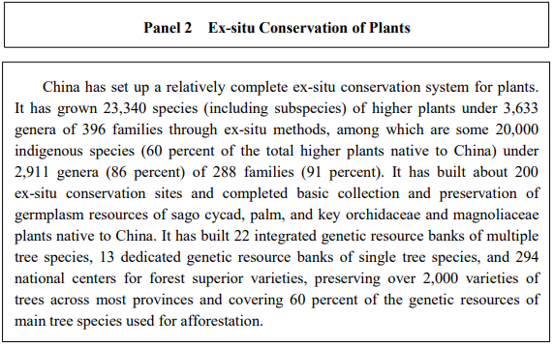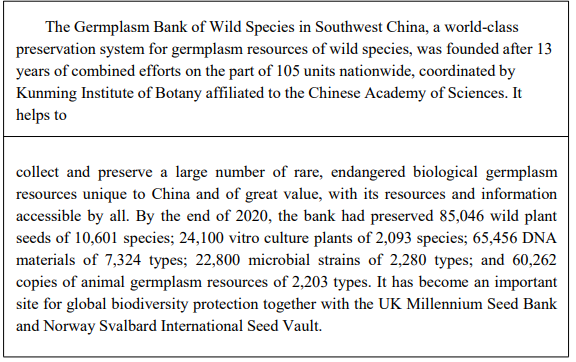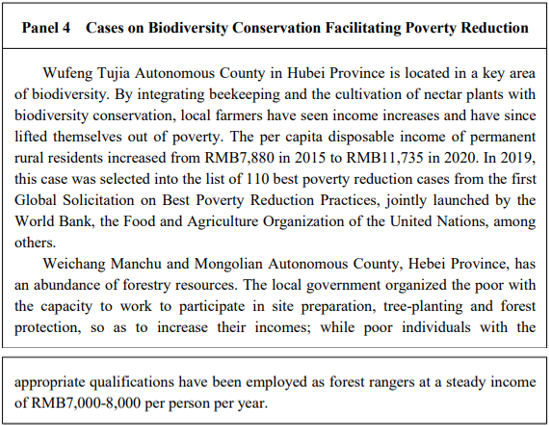

Biodiversity Conservation in China
II. Increasing the Efficiency of Biodiversity Conservation
China advances biodiversity conservation and development in parallel. It has proposed and implemented measures such as building the national parks system and setting ecological conservation red lines (ECRLs), strengthened in-situ and ex-situ conservation, reinforced biological security management, improved the eco-environment, and coordinated the conservation of biodiversity with green development, thereby making significant gains in protecting biodiversity.
1.Optimizing In-situ Conservation
China is setting up protected areas (PAs) and opening national parks on a trial basis, to create a PA framework with a focus on national parks. It was the first in the world to propose and implement the red line strategy for ecological conservation, and has designated priority areas in biodiversity conservation. These measures have contributed to the conservation of key natural ecosystems, biological resources, and habitats for key species.
Developing a PA system with a focus on national parks. Since 1956 when the first nature reserve was set up, China has established close to 10,000 PAs of all types and at all levels, accounting for about 18 percent of its total land area. In recent years, it has built a PA system with national parks as the mainstay, supported by nature reserves and supplemented by nature parks, laying the foundation for protecting natural habitats, improving the eco-environment, and protecting ecological security in the country. Since 2015, it has launched on a trial basis 10 national parks, including one at Sanjiangyuan, the cradle of the Yangtze, Yellow and Lancang rivers. The relevant PAs have been integrated into these national parks under unified management, comprehensive protection and systematic restoration.
The well-planned PA system has brought 90 percent of terrestrial ecosystem types and 71 percent of key state-protected wildlife species under effective protection. The habitats for wild animals have been expanding and their populations are growing. The population of giant pandas in the wild has grown from 1,114 to 1,864 over the past four decades. The crested ibis population has increased from only 7 to over 5,000, with both wild species and artificial breeds counted. The Asian elephant population in the wild has grown from 180 in the 1980s to about 300 at present. The wild population of Hainan Gibbon has increased from no more than 10 in two groups 40 years ago to 35 in 5 groups.

Setting and applying red lines for ecological conservation. Setting ECRLs is an important institutional innovation in China's land use planning and eco-environmental reform. China employs this innovative model to bring essential ecological functional areas for biodiversity conservation and the most ecologically fragile regions under the ECRLs and apply stringent conservation measures to them. The areas initially defined under the initiative are mainly distributed across China's ecological security barriers and areas such as the Qinghai-Tibet Plateau, Tianshan Mountains, Inner Mongolian Plateau, Greater and Lesser Xing'an Mountains, Qinling Mountains, Nanling Mountains, Yellow River Basin, Yangtze River Basin, and coastal zones. At present, they cover various important ecosystems such as forests, grasslands, deserts, wetlands, mangrove forests, coral reefs and sea grass beds across key regions of biodiversity all over the country, bringing most rare and endangered species and their habitats under protection.
China's proposal - Drawing a "Red Line" for Ecological Protection to Mitigate and Adapt to Climate Change - has been selected by the UN as one of the 15 best Nature-based Solutions around the globe. Drawing ECRLs and biodiversity protection are strategies for the same goals in the same areas. Setting red lines will effectively improve the function of ecosystems and maintain the basic ecological space necessary for national ecological security and sustainable economic and social development.
Designating priority areas for biodiversity protection. China is connecting the current PAs across different administrative regions. Giving full consideration to key biogeographical components and different types of ecosystems, it has designated 35 priority areas for biodiversity protection. Among these, 32 terrestrial priority areas cover a total of 2.76 million sq km and make up about 28.8 percent of the total land area. They are valuable in effectively protecting key ecosystems, species and their habitats.
2.Improving Ex-situ Conservation
China continues to step up ex-situ conservation, and launches systematic campaigns to save endangered species. More biological genetic resources are collected and better preserved, and the ex-situ conservation system is improving as an effective complement to in-situ conservation, helping to protect and restore many species of endangered wildlife.
Gradually improving the ex-situ conservation system. China has set up a relatively complete ex-situ conservation system including botanical gardens, wildlife rehabilitation and breeding centers, germplasm resource centers, and gene banks. To date, China has built a total of about 200 botanical gardens and arboretums exhibiting 23,000 species of plants, and 250 wildlife rehabilitation and breeding centers where over 60 types of rare and endangered wild animal are successfully bred.

Accelerating the collection, preservation and use of key genetic resources. China attaches great importance to protecting biological resources, and has made considerable progress in the research on biological resources and their collection and preservation in recent years. To steadily increase protection and use of wildlife resources, China has rolled out special plans for strategic biological resources, which have helped to improve bio-resource collection and preservation platforms, and create platforms for germplasm resource innovation and natural compound transformation as well as libraries for derivatives of genetic resources. It has launched a batch of projects for germplasm resource protection and breeding. By the end of 2020, China had put in place a national crop genetics protection system with the national long-term germplasm banks and their duplicates as the core, supported by 10 medium-term banks and 43 germplasm fields. It had built 199 state-level livestock and poultry germplasm resource preservation fields (areas, storehouses), preparing state-level sites for the conservation of germplasms of over 90 percent of breeds under the National Catalogue of Livestock and Poultry Genetic Resources. There are over 520,000 copies of crop germplasm resources and 960,000 copies of livestock and poultry genetic resources in long-term storage. China has established 99 state-level germplasm resource banks for trees, and two state-level germplasm resource sub-centers for trees and grass in Xinjiang and Shandong, preserving 47,000 copies of germplasm resources for trees. It has also built 31 germplasm preservation fields and two germplasm resource centers for medicinal plants, preserving over 12,000 copies of seeds and seedlings.


Launching well-planned campaigns to save endangered species. China has launched campaigns to rescue rare and endangered wildlife, expand their population through artificial breeding, and reintroduce them to natural habitats in a phased manner. The captive population of breeding pandas has grown in numbers and quality. They have been downgraded from "endangered" to "vulnerable" on the list of species at risk of extinction, and some have been released into natural habitats to integrate into the wild population. Elks, once nowhere to be found in the wild, have grown to 8,000 in number thanks to the three conservation bases in Nanhaizi of Beijing, Dafeng of Jiangsu, and Shishou of Hubei. Emergency measures have also been taken to save and protect 120 plant species with extremely small populations such as the Cycas debaoensis, Manglietiastrum sinicum and Abies beshanzuensis, and to restore to their natural habitats 112 species of rare and endangered wild plants native to China.
3.Improving Biosecurity Governance
China attaches great importance to biosecurity, and has included it in the national security system. The Biosecurity Law was promulgated and came into force in 2021. There is systematic planning for biosecurity risk control and governance. Efforts have been made to improve the mechanism for preventing the invasion of alien species, promote the sound development of biotechnologies, and strengthen the protection, supervision and regulation of biogenetic resources. The aim is to constantly improve national biosecurity governance.
Preventing the invasion of alien species. China has made greater efforts to guard against and respond to the invasion of alien species. It has improved the collective response to invasive alien species by putting in place inter-ministerial coordination mechanisms. China issued the List of Invasive Alien Species in China in four groups in 2003, 2010, 2014 and 2016 respectively, and the List of Key Invasive Alien Species under State Supervision in 2012, covering a total of 83 invasive species detected in the country. China has brought invasive alien species under survey, monitoring, early warning, control and extermination. Stronger port quarantine measures have helped to prevent the entry of invasive alien species and reduce the risk of wildlife epidemics.
Improving safety administration of genetically modified organisms (GMOs)。 China has tightened the regulation of biotechnologies and bio-products, and promoted the sound and orderly development of biotechnologies. A succession of laws and regulations have been promulgated, including Regulations on the Safety Administration of Genetically Modified Organisms in Agriculture (2001), Measures for the Safety Assessment and Administration of Genetically Modified Organisms in Agriculture (2002), Measures for the Safety Administration of Biotechnology Research and Development (2017), and Measures for the Administration of Inspection and Quarantine of Inbound and Outbound Genetically Modified Products (2004)。 Safety testing and assessment of GMOs has been conducted to prevent any potential negative impact on biodiversity conservation and on the sustainable utilization of bio-resources resulting from the release of GMOs into the environment. With the issuance of over 200 technical norms on the safety testing, assessment, supervision and regulation of GMOs, a national system of GMO safety administration is being completed in steps.
Strengthening the supervision of biogenetic resources. China has tightened management and oversight on the conservation, acquisition, utilization and benefit-sharing of biogenetic resources. China has conducted surveys on essential biogenetic resources and conservation performance evaluations, to identify the scale, distribution, conservation and utilization of these resources.
• China organized the fourth national survey on Traditional Chinese Medicine (TCM) resources in 2018, and pinpointed the genetic affiliation and distribution of over 13,000 varieties, including 3,150 varieties unique to China.
• China is conducting the third national survey on and collection of crop germplasm resources (2021-2023), with a total of 92,000 samples having been collected, more than 90 percent of which are newly identified varieties.
• China is conducting the third national survey on livestock and poultry genetic resources (2021-2023), and has completed the preliminary identification of 8 new species.
• China launched the first national survey on forest and grass germplasm resources in 2019, and has completed a pilot survey in the nature reserves along the Qinling Mountains.
In the past decade, China has identified about 200 new varieties of plants per annum, accounting for 10 percent of the global figure. China is accelerating legislation on accessing and sharing the benefits of biogenetic resources, strengthening their conservation, supervision and regulation, and preventing their loss or chaotic utilization.
4.Improving the Eco-environment
Improving and stabilizing ecosystems plays a fundamental and strategic role in ensuring national ecological security. China has therefore intensified efforts in eco-environmental conservation and restoration, and launched a series of projects for the integrated conservation and restoration of mountains, rivers, forests, farmland, lakes, grasslands, deserts, glaciers and snow mountains. As a result, ecological deterioration has been contained, and ecosystems are generally stable, with a greater capacity to serve development. China has been fighting a tough battle against pollution; currently, the pressure on biodiversity conservation is greatly eased, the eco-environment keeps improving, and a framework of shields for ecological security has been largely completed.
Implementing eco-environmental conservation and restoration projects. To restore degraded ecosystems, and improve and stabilize them, China has carried out multiple conservation and restoration projects, which have succeeded in improving and restoring wildlife habitats in key regions.
• China has implemented key ecosystem-related projects including conservation and restoration of natural forests, sandstorm source control in Beijing and Tianjin, stony desertification control, the Three-North (i.e., Northeast China, North China and Northwest China) Shelterbelt Forest Program and other key forest programs, programs turning marginal farmland into forests and grasslands, programs returning grazing lands to grasslands, conservation and restoration of lakes, rivers and inland wetlands, and conservation and restoration of mangrove forests and coastal wetlands.
• China has launched 25 pilot projects and 10 integrated projects for the conservation and restoration of mountains, rivers, forests, farmland, lakes, grasslands, and deserts.
• China has enacted the Master Plan on Major Projects for the Conservation and Restoration of National Key Ecosystems (2021-2035), specifying an overall conservation configuration for the new era composed of Three Eco-zones and Four Shelterbelts - Qinghai-Tibet Plateau Eco-zone, Yellow River Eco-zone, Yangtze River Eco-zone, Northeast Shelterbelt, North Shelterbelt, South Shelterbelt, and Coastal Shelterbelt.
Through the above actions, China has achieved the following:
• China's forest coverage and forest reserve have both maintained growth for the last 30 years, and China has realized the largest growth in forest resources among all countries in the world.
• China's desertification coverage and sandy desertification coverage have both decreased in three successive monitoring periods. Its steppe vegetation coverage rate has reached 56.1 percent and the steppe ecosystems have continued to improve.
• Between 2016 and 2020, China restored 1,200 km of coastline and 23,000 ha of coastal wetlands.
• Between 2000 and 2017, China contributed about 25 percent of global vegetation growth, the biggest share among all countries.
Tightening pollution control. Good environmental quality is both the foundation and goal of biodiversity conservation. China has announced a battle against pollution to improve air, water and soil quality.
Through an increasing effort to combat pollution, China has achieved the following:
• In 2020, China's average concentration of ambient particulate matters (PM2.5) was 33 ?g/m3 , down by 28.3 percent from 2015, and the percentage of days with good air quality rose by 5.8 percentage points from 2015.
• In 2020, the combined proportion of state-controlled water sections with good-quality surface water reaching Grades I, II and III was 83.4 percent, up by 17.4 percentage points from 2015; and that of water sections with bad quality surface water below Grade V was 0.6 percent, down by 9.1 percentage points from 2015.
• In 2020, the combined proportion of good quality offshore waters reaching Grades I and II was 77.4 percent in terms of area, up by 9 percentage points from 2015.
• In 2020, the safe utilization rate of contaminated arable land and that of contaminated land both exceeded 90 percent. A better eco-environment has provided better wildlife habitats, which has helped restore the functions of varied ecosystems and greatly eased the pressure from biodiversity loss.
5. Promoting Green Development with Coordinated Efforts
China endeavors to advance social and economic development within the carrying capacity of supporting ecosystems. Measures have been taken to transform the economic growth model, encourage green and low-carbon ways of life, and coordinate efforts in biodiversity conservation and high-quality development.
Accelerating the green transformation of all sectors and industries. Upholding the new development philosophy, China pursues green development with the priority given to eco-environmental conservation. Efforts have been made to promote the green transformation of all sectors and industries in social and economic development, to balance economic development with eco-environmental protection, and to reduce the pressure on biodiversity.
China is moving faster in building an economic structure that facilitates green, low-carbon and circular development, aiming to improve industrial structure, raise the efficiency of resource utilization, promote cleaner production, increase the proportion of green industries, and accelerate the green transformation and upgrading of primary, secondary and tertiary industries and their infrastructure.
China encourages eco-friendly planting and breeding industries and sustainable operations. It has formulated guidelines on sustainable production for better conservation of bio-resources. It has improved the certification of green products such as green food, organic farm produce, forest products with ecolabels, and sustainable aquaculture products. China is leveraging innovative technology in protecting biodiversity, and sustainably utilizing bio-resources in the fields of agriculture, forestry, fishery and animal husbandry.
China has put in place systems for the utilization and administration of key wildlife resources, such as hunting licenses, collecting permits, and domesticating and breeding certificates, and encourages conservation and sustainable utilization of premier bio-resources.
Promoting green urban and rural development. China is coordinating its efforts in biodiversity conservation and rural revitalization, with the former as a precondition. It has endeavored to explore competitive resources, develop eco-friendly industries, promote green and high-quality development in both urban and rural areas, and build a beautiful homeland featuring harmonious coexistence of humanity and nature.
China takes into full account eco-environmental factors in the process of rural revitalization. With an aim to promote rural progress and improve farmers' living standards, it has redoubled efforts in preserving bio-resources, as a means of facilitating sustainable development.
China is building national demonstration zones for eco-environmental progress, national model cities for environmental protection, national eco-park cities, and national park cities. The aim is to strengthen biodiversity conservation in urban areas, optimize the urban ecological spatial configuration, improve urban ecosystems, and enhance the people's sense of gain, happiness and security from the eco-environment.
China has been encouraging green and low-carbon ways of life, such as green consumption, green travel and green housing, to reduce the consumption of natural resources.
Realizing the market value of green products. Practicing the concept that lucid waters and lush mountains are invaluable assets, China has worked to realize and increase the market value of green products, and seek new growth engines for high-quality development.
China has established a sound mechanism for realizing the market value of green products, and is working on a policy framework for turning "lucid waters and lush mountains" into "invaluable assets".
China has piloted mechanisms for the marketing of green products in the Yangtze River Basin and Sanjiangyuan National Park, and established bases for turning natural resources into economic gains. Efforts have been made to devise marketing strategies for green products, which are overseen by the government, adapted to commercialized operation, and support sustainable development, and in which enterprises and all sectors of society participate. The aim is to turn eco-environmental strengths into growth drivers for quality development and motivate the public to preserve biodiversity.

Source: <https://english.mee.gov.cn/Resources/publications/Whitep/202110/P020211008419847485077.pdf>